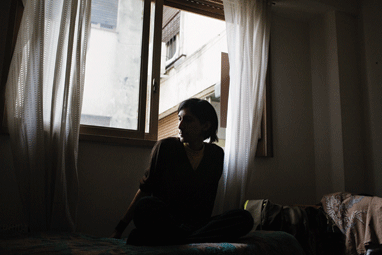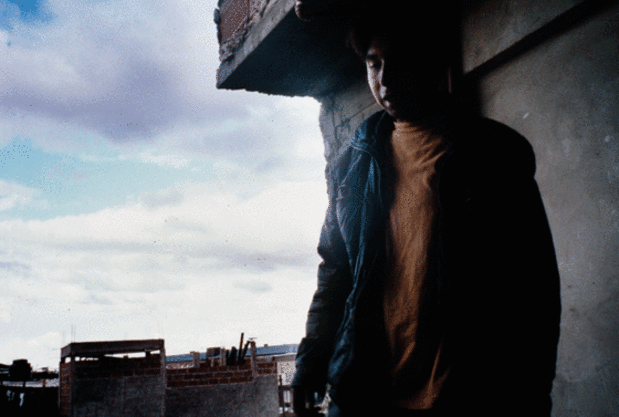For more than a year now little bits of cumbia detritus have been washing up on our screens from all corners—white labels from SF’s Bersa Discos label, uncredited cumbia crunk border radio-style party blends from somewhere in TX, uncredited youtube clips of dubbed out accordion jams...After awhile we felt the need to get the full story behind these mysterious artifacts, so we enlisted the most well-rounded cumbiologist we know; DJ /Rupture aka writer Jace Clayton, to get on the case.
Having been involved in everything from remixes to chicha and Colombian roots reissues, Jace seemed uniquely positioned to give us an overview of the century old genre, so we took him at his word when he said Buenos Aires was the current hot spot and the ultimate origin point of much of the stuff we’d been hearing and hearing about. One plane ticket later, Jace and photographer Gabriele Stabile had embarked on a documentary mission to BA that resulted in a Summer Music issue feature. And now here it is in web-form; back on our screens, where it all started. After you're done reading the feature, check out Jace guest columning this week's Ghetto Palms on cumbia here.
Story Jace Clayton
Photography Gabriele Stabile
“What’s up? You should put on your seatbelt.” So says Pablo Lescano as I climb inside his SUV, en route to the first of two gigs his six-piece band Damas Gratis is headlining tonight in Buenos Aires. The king of Argentine cumbia drives something like he plays the keytar: twitchy, generous, impulsive. “Friday’s not the big night for parties,” he explains, one hand on the wheel, the other flipping through CD-Rs so that the fat-ass cumbia basslines announcing our presence to the block change every sixty seconds or so. “Tomorrow we play nine different shows. We’ll have to drive fast.” The downtown that slides past his tinted windows looks like a whiter version of Paris, but Lescano hails from tropical northern Argentina, which never gave a damn about Europe, much less the States. We screech to a halt, avoiding a fender-bender by a few inches. “We play like a live DJ,” he explains. “When one song gets tired—poom!—we rip into another. We don’t do set lists. We pull out anything.” Damas Gratis—which means “Ladies Free”—could easily draw a crowd of fifteen thousand, but here in Argentina, no venue wants that many cumbia fans—poor, young, from the wrong barrios—gathered in one place. So they play fifteen separate thousand-person shows in two days. Call it distributed stardom, as good a metaphor as any for the global spread of cumbia, a category as wide as rock in Latin America.
According to one legend, cumbia is what happened when Colombian natives and black slaves found accordions washed onshore from a German shipwreck. Some view its tropical skank as the missing link between upbeat salsa flash and the dubwise languor of reggae. The deceptively simple sound mutates everywhere it goes, but its telltale hallmark is an unhurried 4/4 groove built around low drums and raspy shakers in a distinctive slow train pattern. These days the classic minor key accordion melodies are interchangeable with guitar, flutes or synths (cumbia’s not dogmatic). Old and new singers love to shout “Cuuuuumbiiaaa,” distending their syllables the way the genre stretches meaning.
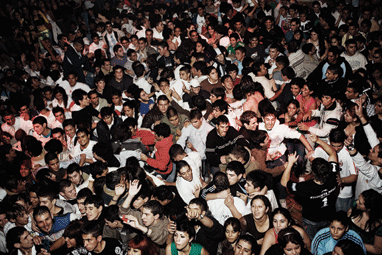
The folk style crept into mainstream popularity in Colombia nearly one hundred years ago and by mid-century, cumbia colombianas had swelled into dapper big band orquestas. The only folks who still actively appreciate the tropical rhythm in its homeland are grandparents (hooked on classics from Medellín powerhouse label Discos Fuentes) and soccer hooligans (who blast Damas Gratis). But 20th century currents of migration and chance spread cumbia from neighboring Panama to distant Buenos Aires. 1960s brown-power Amazonian bands like Los Mirlos from Peru swapped the lead accordion for ayahuasca-friendly swamp guitars and effects pedals, renaming the sound chicha after the local firewater. A climb of the Andes around the same time would find cumbia already there, played in pentatonic scales on indigenous flutes.
In the ’80s, the same synth presets, androgynous hairspray and drum machines that revolutionized global pop hit cumbia hard. Selena inadvertently christened the electrified style “tecnocumbia” with her hit of the same name. In Mexico, its biggest market, cumbia can mean everything from boy band cheese to Celso Piña’s dubby anthem “Sobre el Rio” to the slo-mo psychedelia of cumbias rebajadas, whose practitioners had been down-pitching cumbia tunes a good three decades before DJ Screw brought the same lazy genius procedure to Houston rap. Tecnocumbia loves its octopad drums, while the sampled beats of cumbia sonidera rule huge Mexican parties from LA to outer-borough New York, with sonidero selectors who never stop talking over their instrumentals. Meanwhile, bilingual Tejano DJs in Dallas have started sampling cumbia, making what sounds like Miami bass with accordion riffs and English language crunkapellas. For decades cumbia has subdivided, quietly becoming one of the Latin America’s most popular styles, inspiring everyone from Manu Chao to Voltio. But it wasn’t until a young Argentine with a squeaky voice named Pablo Lescano emerged with acid keyboards and villa slang that cumbia exploded into the 21st century with ruthless infectiousness.
“Todos los negros con las palmas arriba!” shouts Lescano. (All my blacks throw your hands in the air!) On stage, the stocky Argentine resembles a stretched out version of football legend Diego Maradona—stormy coke history and tracksuit included. Never mind that Lescano and his fans are all white, “los negros”—the thousand-plus kids gathered in north Buenos Aires’ Fantastico club—comply with a roar. This isn’t a rock show—they are dancing to slow cumbia, moshing to century-old Colombian folk. “It’s not like salsa or tango, where you need to learn the steps or have a partner,” says a cumbiambera in the crowd. “With cumbia there are no rules.”
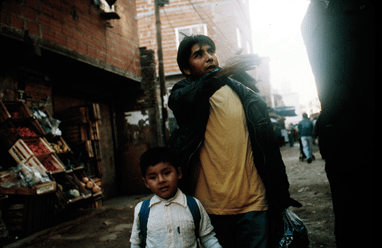
When Lescano began as a keyboardist and arranger in the late ’90s, Argentine cumbia was boring. The clean-cut presentation and romantic lyrics contained zero traces of the Colombian fire that had propelled it so far. Lescano injected real talk about drugs, girls and crime with the slang of the villa. At the same time, his unsettling keyboard style—all edgy playing and multiple voice shifts per song—captured the queasy excitement of a pibe’s night out. “Like a soundtrack for taking cocktails of box wine and pills, his keyboard playing transmits something very acidic and cheap in a certain sense,” says Sonido Martines, a DJ and record dealer from Buenos Aires. Before long Lescano had single-handedly invented a new cumbia style, the gangsta rap analog called cumbia villera. You could clock the skyrocketing success of Damas Gratis by the number of overnight imitators.
Clothing thrown onstage reaches Lescano, but not the guitarist tucked behind him who rushes through a thirty-second solo while Lescano takes a Pepsi break. The audience doesn’t notice. In that instant it’s easy to see how cumbia can be so divisive in a city as rockist as Buenos Aires—a city with a subculture of mulleted girls called “rollingas,” after the Rolling Stones. Cumbia disregards the guitar hero and celebrates the sweaty, swampy glory of all things tropical—exactly what “white” Buenos Aires ignores by looking wistfully towards Europe. Cumbia draws a cultural line. In Buenos Aires, you have to take sides.
I met Lescano the night before at Zizek, a safe club in the upscale Palermo Soho district—a part of town where both “real” blacks like myself and “los negros” from the villa receive nasty looks in restaurants. Like the holy trinity of porteño cuisine—pizza, pasta, empanadas—the Zizek party is filling, but blandly international. Internet buzz had my expectations up, but the pretty, polite cosmopolitans getting loose to reggaeton, hip-hop and cumbia could be anywhere: Barcelona, Prague, Amsterdam. You can’t discern Zizek’s magic until you step into the enormous backstage room. Here a dozen producers sip Fernet-and-Cokes as they swap data or plan collaborations, short-circuiting the segregationist logic of Buenos Aires. The residents of Palermo Soho avoid the rougher bailantas where cumbia lives and message boards flare up with comments like, “I can’t believe they’re letting these blacks in the club!” whenever Lescano swings by to DJ. Zizek takes its name and ethos from Slavoj Zizek, a bearish 59-year-old Slovenian philosopher/iconoclast wedded to a twenty-something Argentine model named Analía. “He’s kind of bastard,” explains Villa Diamante, one of the resident DJs,. “When they ask me what type of music I play, I say bastard pop. It’s not hip-hop, not electronica, not cumbia. It’s more of a way of dealing with the music.” Diamante continues, “When we started [Zizek] a year and a half ago, we debated whether or not to put ‘cumbia’ on the flyer.” He and the two other founders, a Texan expat and an Argentine, knew cumbia’s bad rep—signifying either syrupy love songs or villera’s thugged out alternative—would surely drive some audience members away, but it had to be there.
Zizek’s hipsters aren’t likely to venture to the home turf of DJ Vampiros, a short Bolivian in a leather jacket whose over-pronounced canines and nocturnal lifestyle earned him the moniker. We sit in a tiny workshop on the second floor of his self-built cinderblock house in one of Argentina’s most dangerous neighborhoods, Bajo Flores. His wife comes in again. “But did they see you enter here?” This is the fifth time she’s asked. She’s worried, with reason. Walking home with Vampiros and his impish five-year-old son Anthony, two boys on a motorbike buzzed by us, staring down FADER photographer Gabriele Stabile to make sure he saw their cocked nine-millimeter: international sign language for lose the camera. Uniformed police can’t enter Bajo Flores. A web of young “soldiers” protect the stash house kitty-corner from Vampiros. The boys returned, their motorbike’s diesel sputter temporarily drowning out the two nearby bands in earshot. The camera was out of sight by now, but the gun remained in view in case that changed. They drove away slow, the kid on the back staring. Anthony held my hand, giggling. “This neighborhood used to be real heavy,” says Vampiros. “Guys on the corner with a gun in each grip. Crazy things happening. But it’s calmer these days. Because the insecurity has spread—it’s all over Argentina now.”
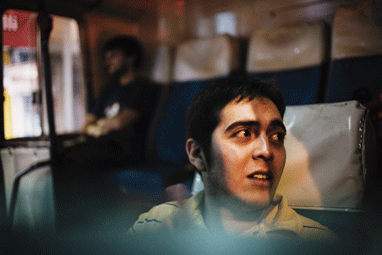
The 2001 economic crisis saw the real value of the Argentine currency plummet by seventy-five percent. Folks with $100,000 in the bank suddenly had $25,000. The underclass hemorrhaged, rich turned poor. Who could stomach flowery love songs after that? This nasty reality slap boosted cumbia villera’s popularity to astronomical heights. “The villa is in a state of emergency,” says Lescano. “A kid dies in the villa and it doesn’t matter. You say ‘black’ not for the skin color but for the barrio you live in.” The lethal popularity of a cheap new drug called paco (like crack, but worse—few addicts survive past six months) has made edge living even more raw. But a bizarre umbilical connects freedom and neglect. Even though cumbia has maintained incredible popularity across South America for decades, its mala reputación meant that it never garnered much external interest. Cumbia kept growing, with nobody to answer to but its fans and followers.
Off the radar, cumbiamberos keep their musical rules open enough to dance with a delicious liberty. Between MySpace and endless mp3s, internet-savvy cumbia fans are slowly getting a picture of how far and wide the sound has traveled. Contemporary cumbias first edged into the English-speaking mainstream with the inclusion of “Sobre El Rio” in the 2006 film Babel. In 2007 cumbia made further inroads abroad when Swiss-Iranian club producer Samin sampled Alberto Pachero’s version of the ultra-popular “Cumbia Cienaguera” for “Heater.” Simultaneously, indie kids were learning about cumbia from the late ’60s guitar visionaries on the reissue comp Roots of Chicha: Psychedelic Cumbias From Peru. Then came two Bay Area expats living in Buenos Aires, DJs Oro 11 and Disco Shawn. The duo came from reggae and indie rock backgrounds respectively, but met over a love of cumbia and launched their Bersa Discos label back in Cali in late 2007. “We just wanted to help get this music out there, beyond the CD-R releases, mp3s and bootlegs floating around Buenos Aires,” says Shawn. Their first 12-inch contains three songs from cumbia genius El Hijo de la Cumbia, along with dubstep cumbiambero from Dale Duro. Talking about their monthly San Francisco party, Tormenta Tropical, Shawn says, “No one knew the songs and lots of people couldn’t even understand the lyrics, but the dance floor was jumping.” Language barriers mean little to cumbia and these unexpected migrations come as no surprise. (Remember those shipwrecked accordions?) Now beat-scavenging bloggers and DJs sniffing for roughneck world music are Soulseeking mp3s for their Serato crates and crunk cumbia mixes thrown on YouTube are getting half a million views. Cumbia is arriving from all directions. And leaving.
Many young Latinos still regard cumbia as casposa—“bad taste dandruff.” Calle 13 poked fun at the genre’s geriatric associations with “Cumbia de los Aburridos” (“Bored Folks’ Cumbia”), on its 2007 album, but in Buenos Aires there’s no denying the power of the phenomenon. “When you see Damas Gratis, you see the light,” says Martin Roisi of Fantasma, a cumbia-rap hybrid act and one of many villera-inspired artists operating in Lescano’s shadow. “You see god.” Roisi doesn’t smile, he’s being serious. It’s hot, it’s not. It’s poetry, it’s crap. Accelerate and break, swerve around oncoming traffic, squeeze into places where nobody thought it could fit. Lescano’s vehicle operates like the genre itself.
